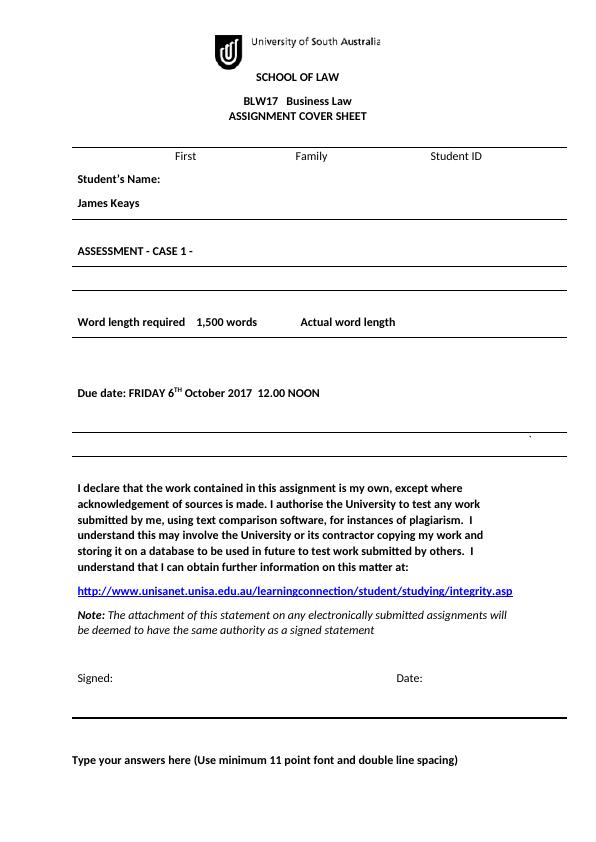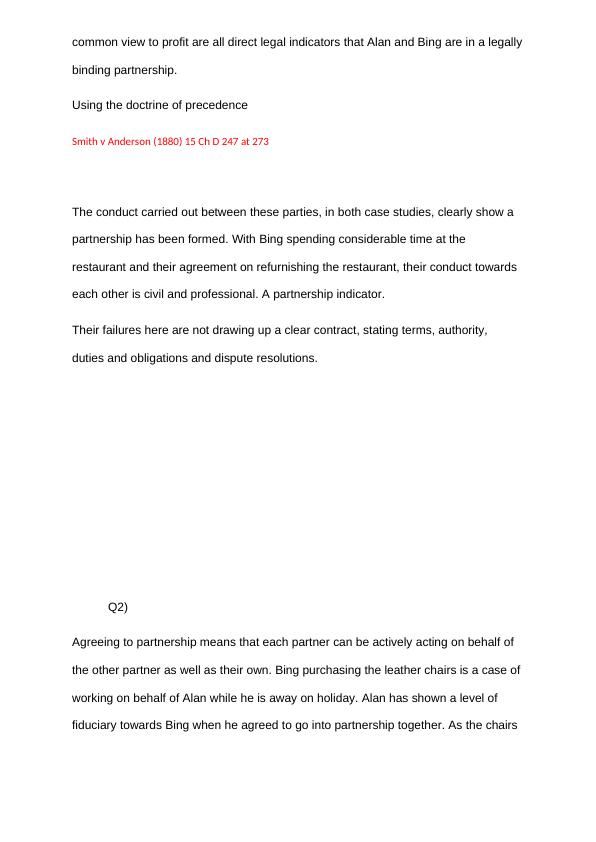BLW17 Business Law Assignment
Added on 2020-03-16
10 Pages1823 Words48 Views
SCHOOL OF LAWBLW17 Business LawASSIGNMENT COVER SHEET First Family Student IDStudent’s Name:James KeaysASSESSMENT - CASE 1 - Word length required 1,500 words Actual word lengthDue date: FRIDAY 6TH October 2017 12.00 NOON `I declare that the work contained in this assignment is my own, except where acknowledgement of sources is made. I authorise the University to test any work submitted by me, using text comparison software, for instances of plagiarism. I understand this may involve the University or its contractor copying my work and storing it on a database to be used in future to test work submitted by others. I understand that I can obtain further information on this matter at: http://www.unisanet.unisa.edu.au/learningconnection/student/studying/integrity.aspNote: The attachment of this statement on any electronically submitted assignments will be deemed to have the same authority as a signed statementSigned:Date:Type your answers here (Use minimum 11 point font and double line spacing)

Q1) According to the partnership act 1891 (SA), ‘a partnership may be formed expressly or impliedly’. What was the intention of the parties? Did they share profits and losses? Have both parties had a voice in management? Is there continuity in trading activities? In the case study Peking Duck Restaurant, the owner Alan and lender Bing, have failed to communicate effectively and correctly to clearly outline the terms, nature and authority of their deal. Although a deal has been struck, the contract is extremely vague, creating issues regarding ownership. The contract states that the lender, Bing, will receive a 40% share of profits and losses. This means there was a relationship formed with a view for profit. This, as well as, alreadyhaving a private friendship shows a level of fiduciary. The contract also states that ‘the lender has the right to any major decisions regarding the business’. When Alan and Bing both agree that the way to improve trade is to refurnish the restaurant, they are effectively showing they are making jointdecisions, to enhance profits and increase sales. According to the ‘partnership act 1891’, this means Bing has a voice in management, a key indicator to a partnership. When Alan and Bing decide to purchase furniture with the money Bing has provided,they now have common ownership of property according to the partnership act 1891.A partnership indicator is a continuity and repetition of trade. With Bing spending considerable time at the restaurant, suppliers have come to know him as a partner. This means according to the ‘partnership act’ they have been dealing with him continuously and repetitively. The sharing of profits and losses, having a voice in management repetition of trading activities, common ownership and having a

common view to profit are all direct legal indicators that Alan and Bing are in a legallybinding partnership. Using the doctrine of precedence Smith v Anderson (1880) 15 Ch D 247 at 273 The conduct carried out between these parties, in both case studies, clearly show a partnership has been formed. With Bing spending considerable time at the restaurant and their agreement on refurnishing the restaurant, their conduct towards each other is civil and professional. A partnership indicator.Their failures here are not drawing up a clear contract, stating terms, authority, duties and obligations and dispute resolutions. Q2)Agreeing to partnership means that each partner can be actively acting on behalf of the other partner as well as their own. Bing purchasing the leather chairs is a case ofworking on behalf of Alan while he is away on holiday. Alan has shown a level of fiduciary towards Bing when he agreed to go into partnership together. As the chairs

End of preview
Want to access all the pages? Upload your documents or become a member.
Related Documents
Law for Business - Partnership, Liability, and Propertylg...
|9
|2011
|128
Legal Issues in Partnership: A Case Study Analysislg...
|8
|2396
|255
